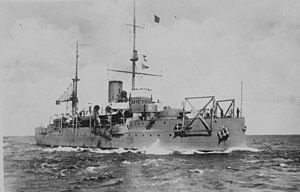 Hertog Hendrik
| |
| History | |
|---|---|
| Name | Hertog Hendrik |
| Namesake | Duke Henry of Mecklenburg-Schwerin |
| Builder | Rijkswerf in Amsterdam |
| Laid down | 8 March 1901 |
| Launched | 7 June 1902 |
| Commissioned | 5 January 1904 |
| Recommissioned | 21 October 1947 |
| Decommissioned | 27 September 1968 |
| Renamed |
|
| Reclassified |
|
| Stricken | 28 August 1969 |
| Fate | Scrapped |
| Name | Ariadne |
| Namesake | Ariadne |
| Acquired | 14 May 1940 |
| Commissioned | 1943 |
| Reclassified | Anti-aircraft battery, 1943 |
| Fate | Handed back to the Netherlands after VE Day |
| General characteristics | |
| Class and type | Koningin Regentes-class coastal defence ship |
| Displacement | 5,002 tons |
| Length | 96.622 m (317 ft 0 in) |
| Beam | 15.189 m (49 ft 10 in) |
| Draught | 5.817 m (19 ft 1 in) |
| Installed power | 6,500 ihp (4,800 kW) |
| Propulsion | 2 shafts, 2 reciprocating engines |
| Speed | 16.5 knots (30.6 km/h; 19.0 mph) |
| Complement | 340 |
| Sensors and processing systems |
|
| Armament |
|
| Armour |
|
HNLMS Hertog Hendrik (Dutch: Hr.Ms. Hertog Hendrik) was a Koningin Regentes-class coastal defence ship (pantserschip) of the Royal Netherlands Navy. The ship was built at the Rijkswerf in Amsterdam at the start of the twentieth century. She was the first ship in the Dutch navy to be equipped with wireless communication. The ship took part in two expeditions to South Celebes and during the Spanish Civil War she performed convoy duties. During World War II she was captured by the invading German forces and converted into an anti-aircraft battery. After the war the ship was recovered and given back to the Netherlands, to be converted into an accommodation ship.